国际经济学第七课2011讲解学习
- 格式:ppt
- 大小:903.50 KB
- 文档页数:4
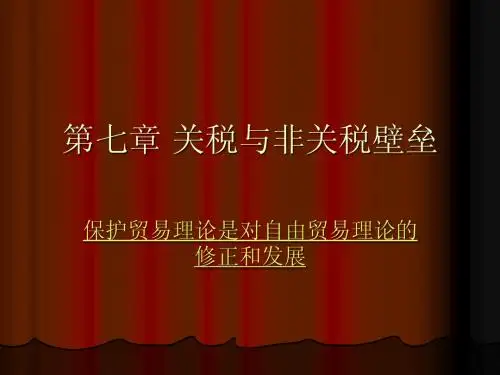



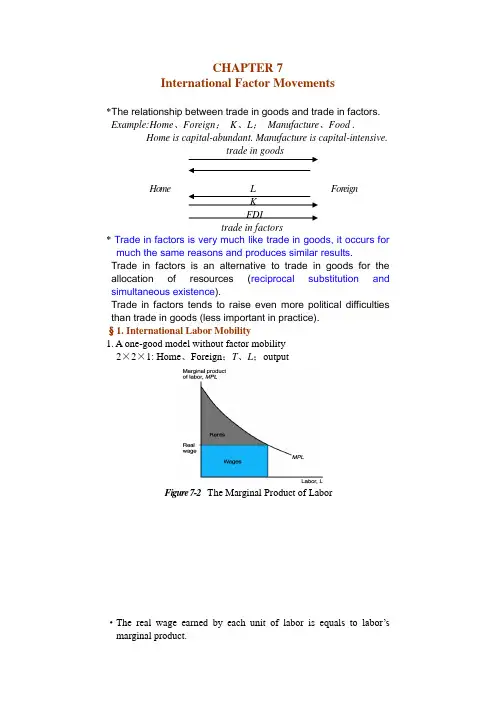
CHAPTER 7International Factor Movements*The relationship between trade in goods and trade in factors. Example:Home、Foreign;K、L;Manufacture、Food .Home is capital-abundant. Manufacture is capital-intensive.trade in goodsHome L For eig nKFDItrade in factors* Trade in factors is very much like trade in goods, it occurs for much the same reasons and produces similar results.Trade in factors is an alternative to trade in goods for the allocation of resources (reciprocal substitution and simultaneous existence).Trade in factors tends to raise even more political difficulties than trade in goods (less important in practice).§1. International Labor Mobility1. A one-good model without factor mobility2×2×1: Home、Foreign;T、L;outputFigure 7-2The Marginal Product of Labor·The real wage earned by each unit of labor is equal s to labor’s marginal product.(1)MPL·P=W W/P=MPL(2)Q=∫0L MPL·dL=Rents+WagesPayment to labor: (W/P) ·L=WagesPayment to land: Rents2.International labor movementIf (T/L)<(T/L)*(W/P)<(W/P)*L↓ L*↑Figure 7-3 Causes and Effects of International Labor Mobility·The outcome of the redistribution of the world’s labor force.(1) W/P=W/P*(2) Q W↑ (the area of ABC)(3) Income distribution within countriesHome: W/P↑ leaves workers better off and landowners worse off Foreign:W/P↓ leaves workers worse off and landowners better off.3.Extending the analysis·To modify the model——two goods·Trade in factors and trade in goods——reciprcal substitution and simultaneous existence.Case study: wage convergence in the age of mass mirgration.Real wage, 1870 (U.S.=100)Percentage increasein real wage,1870-1913Destination countriesArgentina 53 51 Australia 110 1Canada 86 121 United States 100 47 Origin countriesIreland 43 84 Italy 23 112 Norway 24 193Sweden 24 250Source:Jef frey G. Williamson, “The Evolution of Global Labor Markets since 1830:Background Evidence and Hypotheses,” Explorations in Economic History 32(1995), pp.141-196.Case study: Immigration and the U.S. economy .Immigrants as% of native born workers, 1980Immigrants as%of native bornworkers, 1990Change,1980-1990High-schooldropouts12.2 26.2 14.0 High school 4.4 6.1 1.7 Some college 5.8 6.9 1.1 College 7.5 9.7 2.2 Source: George Borjas, Richard Freeman, and Lawrence Katz, “Searching for the effect of immigration on the labor market,” American Economic Review, May 1996.§2. International Borrowing and Lending·A financial transaction—have real consequence—intertemporal trade borrowing: increase(import) present consumption goodsrepayment: decrease(export) future consumption goods1.Intertemporal PPF·Any economy faces a trade-off between present consumption and future consumption ── Intertemporal PPFFigure 7-4 The Intertemporal PPF2.intertemporal productionFigure 7A-1 Detemining Home’s Intertemporal Production Pattern3.How dose a country trade over time?When a country borrows, it get the right to purchase some quantity of consumption at present in return for repayment of some larger quantity in the future; (1+r) times; the relative price of Q P is (1+r).4. Intertemporal comparative advantage and intertemporal tradeFigure 7A-2 Figure 7A-3Home’s intertemporal PPF is biased toward Q P── stronger present productive capacity relative to future productive investment opportunity. If the preferences are the same, the relative price of Q P in Home is lower than the Foreign’s (intertemporal comparative advantage). Home exports present consumption (lending) while Foreign exports future consumption(borrowing).Home: (Q P−D P)(1+r)=D F−Q FForeign: Q F*−D F*=(D P*−Q P*)(1+r)5.International intertemporal equilibrium in terms of offer curve (P184)Figure7A-4 Interational Intertemporal Equilibrium in Terms ofOffer Curves§3. Direct Foreign Investment and Multinational Firms·The distinctive feature of FDI is that it involves not only a transfer of resources but also the acquisition of control. The extension of control is the essential purpose.1. The theory of multinational enterprise·There are additional costs to invest at Foreign, such as costs cause by transportation、communication、information、obstacle of language、the local market rules and government policy. What advantages of MNE S make them have the ability to offset the additional costs and to defeat the local firms? It is their intangible assets such as technology、patents、know-how、brand 、finance、management and marketing etc, which form the ownership advantage of MNE S. ·How do the MNE S use their ownership advantage? Because some intangible assets such as management、marketing、can’t be sold; some assets such as technology、patents are difficult to be sold or it is profitable to use the intangible assets inside rather than outside the firm. (it is difficult for a buyer to know how much knowledge is worth; property rights in knowledge are often hard to establish), thus call the internalizational advantage of MNE S.·How do the MNE S use their internalizational advantage? If Foreign’s resources、labor cost、favorable policy are superior enough to offset the additional costs, Foreign has the advantage of Location. Foreign“O advantage“L”: Location advantageA dynamic model:Export : :marketing cost of exportFDI : :additional cost of FDILicence : :dissipate of ownership advantageThe choice : max (NPV E ,NPV FDI ,NPV L )When t=0, M*<A*<D* When t increasea <e <h c >g >pThe dynamic of TNC s ’ enter foreign market :Export →FDI →Licence 2.Multinational firms in Practice·MNE S play an important role in world trade and investment.·Foreign-owned MNE S play an important role in most economies. Share of sales; share of value added; share of employment.Table 7-1 France, United Kingdom, and United Stated: Shares ofForeign-Owned Firms in Manufacturing Sales, V alue Added, and Employment, 1985 and 1990 (percentages)Sales Value added EmploymentCountry 1985 1990 1985 1990 1985 1990 France26.7 28.4 25.3 27.1 21.1 23.7 United Kingdom 20.3 24.1 18.7 21.1 14.0 14.9 United States 8.0 16.4 8.3 13.4 8.0 10.8*t M **(1)FDIt tt tR C A N PV r --=∑+*tA **(1)t tt L tR C D N PV r --=∑+c***+btt g t pt Ma A e ftD h qt==+=+*(1)EttttR C MN PV r --=∑+πtπL πF πE *t DSource: U.S. Department of Commerce, Foreign Direct Investment in the United States: An Update(1994).·Much of MNE S do could be done without MNE S, that is, MNE S are not as important a factor in the world economy as their visible would suggest.Case study: FDI in the United States.。
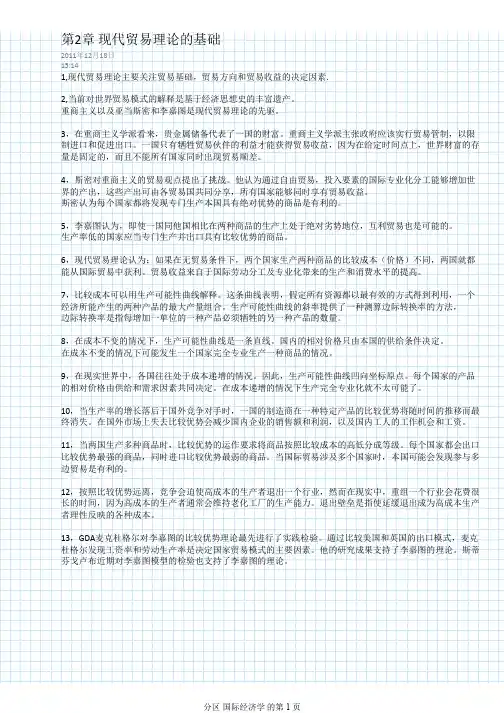
第2章现代贸易理论的基础2011年12月18日15:141,现代贸易理论主要关注贸易基础,贸易方向和贸易收益的决定因素.2,当前对世界贸易模式的解释是基于经济思想史的丰富遗产。
重商主义以及亚当斯密和李嘉图是现代贸易理论的先驱。
3,在重商主义学派看来,贵金属储备代表了一国的财富。
重商主义学派主张政府应该实行贸易管制,以限制进口和促进出口。
一国只有牺牲贸易伙伴的利益才能获得贸易收益,因为在给定时间点上,世界财富的存量是固定的,而且不能所有国家同时出现贸易顺差。
4,斯密对重商主义的贸易观点提出了挑战。
他认为通过自由贸易,投入要素的国际专业化分工能够增加世界的产出,这些产出可由各贸易国共同分享,所有国家能够同时享有贸易收益。
斯密认为每个国家都将发现专门生产本国具有绝对优势的商品是有利的。
5,李嘉图认为,即使一国同他国相比在两种商品的生产上处于绝对劣势地位,互利贸易也是可能的。
生产率低的国家应当专门生产并出口具有比较优势的商品。
6,现代贸易理论认为:如果在无贸易条件下,两个国家生产两种商品的比较成本(价格)不同,两国就都能从国际贸易中获利。
贸易收益来自于国际劳动分工及专业化带来的生产和消费水平的提高。
7,比较成本可以用生产可能性曲线解释。
这条曲线表明,假定所有资源都以最有效的方式得到利用,一个经济所能产生的两种产品的最大产量组合。
生产可能性曲线的斜率提供了一种测算边际转换率的方法,边际转换率是指每增加一单位的一种产品必须牺牲的另一种产品的数量。
8,在成本不变的情况下,生产可能性曲线是一条直线。
国内的相对价格只由本国的供给条件决定。
在成本不变的情况下可能发生一个国家完全专业生产一种商品的情况。
9,在现实世界中,各国往往处于成本递增的情况。
因此,生产可能性曲线凹向坐标原点。
每个国家的产品的相对价格由供给和需求因素共同决定。
在成本递增的情况下生产完全专业化就不太可能了。
10,当生产率的增长落后于国外竞争对手时,一国的制造商在一种特定产品的比较优势将随时间的推移而最终消失。
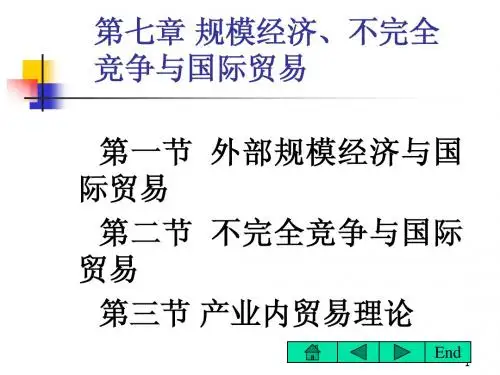
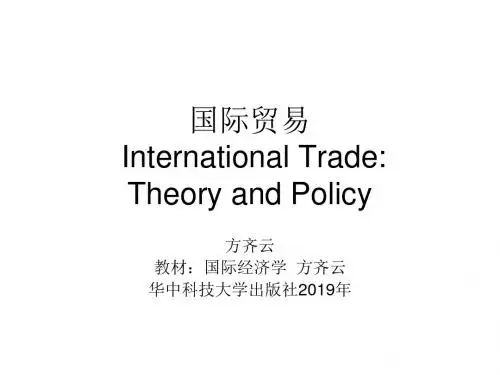
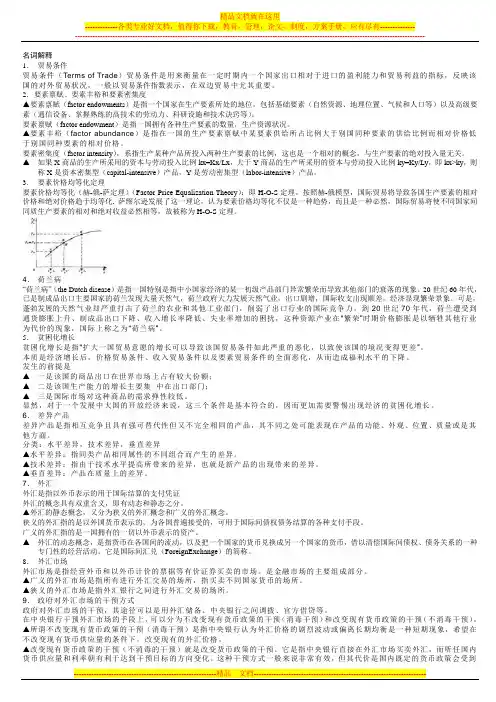
名词解释1.贸易条件贸易条件(Terms of Trade)贸易条件是用来衡量在一定时期内一个国家出口相对于进口的盈利能力和贸易利益的指标,反映该国的对外贸易状况,一般以贸易条件指数表示,在双边贸易中尤其重要。
2.要素禀赋、要素丰裕和要素密集度▲要素禀赋(factor endowments)是指一个国家在生产要素所处的地位,包括基础要素(自然资源、地理位置、气候和人口等)以及高级要素(通信设备、掌握熟练的高技术的劳动力、科研设施和技术诀窍等)。
要素禀赋(factor endowment)是指一国拥有各种生产要素的数量,生产资源状况。
▲要素丰裕(factor abundance)是指在一国的生产要素禀赋中某要素供给所占比例大于别国同种要素的供给比例而相对价格低于别国同种要素的相对价格。
要素密集度(factor intensity),系指生产某种产品所投入两种生产要素的比例,这也是一个相对的概念,与生产要素的绝对投入量无关。
▲如果X商品的生产所采用的资本与劳动投入比例kx=Kx/Lx,大于Y商品的生产所采用的资本与劳动投入比例ky=Ky/Ly,即kx>ky,则称X是资本密集型(capital-intensive)产品,Y是劳动密集型(labor-intensive)产品。
3.要素价格均等化定理要素价格均等化(赫-俄-萨定理)(Factor Price Equalization Theory):即H-O-S定理。
按照赫-俄模型,国际贸易将导致各国生产要素的相对价格和绝对价格趋于均等化, 萨缪尔逊发展了这一理论,认为要素价格均等化不仅是一种趋势,而且是一种必然,国际贸易将使不同国家间同质生产要素的相对和绝对收益必然相等,故被称为H-O-S定理。
4.荷兰病“荷兰病”(the Dutch disease)是指一国特别是指中小国家经济的某一初级产品部门异常繁荣而导致其他部门的衰落的现象。
20世纪60年代,已是制成品出口主要国家的荷兰发现大量天然气,荷兰政府大力发展天然气业,出口剧增,国际收支出现顺差,经济显现繁荣景象。
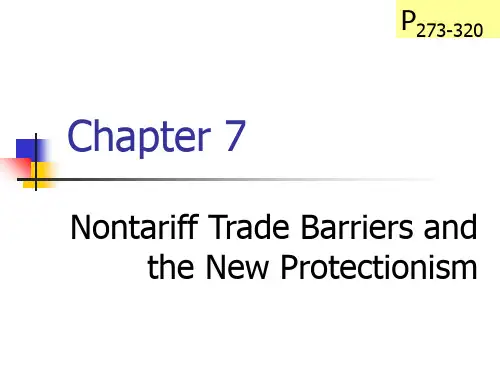

第七章 国际要素流动第 一 节 资本的国际流动( 1学时 )一、国际资本流动的原因一方面国际剩余资金供给充裕,另一方面国际资金需求旺盛,这是国际资本流动的基本原因。
国际资本流动具体受以下几个因素的影响:1.追逐高额利润。
资本投入的首要目标是赚取利润。
除了贸易支付和政府间贷款、国际金融组织贷款外,其他类型的国际资本流动都是为了追求高额的利润。
哪里能获得高额的利润,资本就流向哪里,尤其是长期资本的流动,更是如此。
2.国际风险因素。
国际资本流动的一个重要原则就是安全性,即资本在任何地方投入都应考虑到资本本身的风险。
国际风险是指跨越国境从事信贷、投资和金融交易可能蒙受损失的风险。
投资者在进行国际投资时,风险因素分析是投资评估的必不可少的环节。
一般情况下,投资者在收益率相同时,总是愿意握有风险较小的资产;在风险相同时,总是追求收益率更高的资产形式,这是风险—收益关系之间的最一般的选择。
3.汇率和利率因素。
利率和汇率是市场经济运行中的两大经济杠杆,对国际资本流动的方向和规模有十分重要的影响。
利率的高低在很大程度上决定了金融资产的收益水平,汇率的高低与变化改变了资本的相对价值。
此外,国际收支的状况也会通过汇率对资本的国际流动产生影响。
4.经济政策因素。
一国政府为了吸引或控制国际资本的流入或流出所制定的经济政策对国际资本流动的影响很大。
另外,一国政府的经济发展计划、货币政策、财政政策等也会对国际资本流动产生影响。
二、国际资本流动的经济效应新古典国际资本流动模型。
如果世界是稳定的和可以预见的,国际借贷可以有效地优化资源配置,促进人类福利增长。
这里以两个典型国家为考察对象,本国代表一个获利机会较多但缺少资金的国家,外国代表一个拥有丰裕的资金但国内缺少投资机会的国家。
用图6.1来说明两者间资金流动的经济效应。
'MPK第 二 节 国际直接投资与跨国公司理论( 1 学时 )一、垄断优势理论垄断优势理论由美国经济学家海默(Stephen Hymer )首先提出,并由金德尔伯格(C.P .Kindleberger )等人进一步发展和完善。
迄今为止,我们关注的一直是物品和服务的国际流动。
然而,世界经济的一些最显著的变化是由劳动和资本等生产要素的国际流动引起的。
19世纪,欧洲的资本和劳动力(还有非洲和哑洲的劳动力)流到美国,促进了美国经济的发展。
20世纪60年代,美国向西欧和加拿大大举投资;而在80年代$N90年代,投资又从门本流向美国。
今天,来自南欧的工人在北欧的工厂1鞋作,墨西哥工人向美国移民。
1990年,柏林墙的倒塌促使大量[人离开东德,转向西德。
实际上,生产要素的国际流动与物品和服务的国际流动一样,都受同样的经济力量支配。
如果条件允许三产要素会从要素充裕的国家(生产率较低)移动到要素稀缺的国家(生产率较高)。
不同国家回报率(像:资和资本收益)的差别是生产要素流动的动力。
只要回报高于从一个国家向另一个国家移动的成本,生产要素就会在国际间流动。
.个劳动力稀缺的国家既nr以进口劳动密集型产晶,也町以进口劳动力。
资本也是如此。
因此,物品和服务的国际贸易可以与生产要素的跨国流动相互替代。
在研究国际贸易时,不分析劳动力和资本的国际流动性,是不能得出令人满意的成果的。
本章考察国际资本流动(投资)作为资本密集型产品贸易的替代品所发挥的作用。
重点研究跨国企业,它们是资本在国际范围内再配置的载体。
国际劳动力第10章国际要素流动和跨国企业流动作为劳动密集型产品贸易的替代品,也是本章研究的内容。
跨国企业"企业"这个术语可以准确界定,但对于跨国企业(mu1tinationa1enterpri se,MNE),却没有普遍接受的确切定义。
不过,仔细观察一些有代表性的跨国企业,可以发现,这些企业有很多相同的特征。
跨国企业在许多国家经营,其业务活动除了制造、采矿、精炼和商业服务以外,通常还包括研究和开发活动。
跨国企业超越了国家的界限,所有的经营活动经常接受远离东道国的公司规划中心的指导。
股权和公司管理具有多国化的特征。
一个典型的跨国企业国外销售收入占总销售收入的比重很高,经常达到25%,甚至更多。